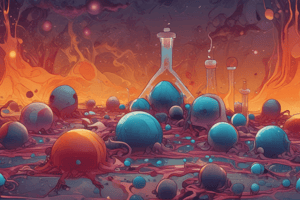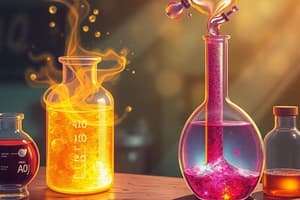Podcast
Questions and Answers
Which of the following substances are different forms of calcium carbonate?
Which of the following substances are different forms of calcium carbonate?
- Limestone
- Chalk
- Marble
- All of the above (correct)
What are the products of the reaction between a metal carbonate and an acid?
What are the products of the reaction between a metal carbonate and an acid?
- Salt and Water
- Salt, Carbon Dioxide and Water (correct)
- Carbon Dioxide and Water
- Salt and Carbon Dioxide
What type of reaction occurs when an acid reacts with a base?
What type of reaction occurs when an acid reacts with a base?
- Oxidation
- Precipitation
- Neutralisation (correct)
- Reduction
What products are formed when a metallic oxide reacts with an acid?
What products are formed when a metallic oxide reacts with an acid?
What is the colour change of phenolphthalein in a basic solution?
What is the colour change of phenolphthalein in a basic solution?
What happens when excess carbon dioxide is passed through calcium carbonate?
What happens when excess carbon dioxide is passed through calcium carbonate?
Which of the following is NOT a product of the reaction metal carbonate/metal hydrogencarbonate + Acid?
Which of the following is NOT a product of the reaction metal carbonate/metal hydrogencarbonate + Acid?
What is the colour of copper(II) chloride in solution?
What is the colour of copper(II) chloride in solution?
What two products are made in a neutralisation reaction?
What two products are made in a neutralisation reaction?
In activity 2.6, what is added to NaOH?
In activity 2.6, what is added to NaOH?
What happens to calcium carbonate when excess carbon dioxide is passed through it in the presence of water?
What happens to calcium carbonate when excess carbon dioxide is passed through it in the presence of water?
Which of the following statements accurately describes the reaction between metal carbonates/hydrogencarbonates and acids?
Which of the following statements accurately describes the reaction between metal carbonates/hydrogencarbonates and acids?
During the neutralisation reaction between NaOH and HCl, what indicates the neutralisation point if phenolphthalein is used as an indicator?
During the neutralisation reaction between NaOH and HCl, what indicates the neutralisation point if phenolphthalein is used as an indicator?
In the reaction between a metallic oxide and an acid, what are the products?
In the reaction between a metallic oxide and an acid, what are the products?
What would be observed when copper oxide reacts with hydrochloric acid?
What would be observed when copper oxide reacts with hydrochloric acid?
What is the general equation that represents a neutralisation reaction?
What is the general equation that represents a neutralisation reaction?
If a solution of NaOH with phenolphthalein turns pink, what will happen if dilute HCl is added drop by drop?
If a solution of NaOH with phenolphthalein turns pink, what will happen if dilute HCl is added drop by drop?
Why does the pink colour of phenolphthalein reappear when NaOH is added to a solution that was previously neutralised with HCl?
Why does the pink colour of phenolphthalein reappear when NaOH is added to a solution that was previously neutralised with HCl?
What does the formation of a blue-green solution when copper oxide reacts with hydrochloric acid indicate?
What does the formation of a blue-green solution when copper oxide reacts with hydrochloric acid indicate?
Considering the reactions of acids and bases, what is the significance of a neutralisation reaction?
Considering the reactions of acids and bases, what is the significance of a neutralisation reaction?
If a solution containing calcium hydrogencarbonate, $Ca(HCO_3)_2$, is heated, what products would you expect to form, assuming the reaction reverses?
If a solution containing calcium hydrogencarbonate, $Ca(HCO_3)_2$, is heated, what products would you expect to form, assuming the reaction reverses?
A student mixes an unknown metal carbonate with hydrochloric acid and observes effervescence. Which gas is being produced, and how can it be confirmed?
A student mixes an unknown metal carbonate with hydrochloric acid and observes effervescence. Which gas is being produced, and how can it be confirmed?
Consider a scenario where a strong acid is added dropwise to a solution containing a weak base and phenolphthalein indicator. What would be observed at the endpoint of the titration, and why?
Consider a scenario where a strong acid is added dropwise to a solution containing a weak base and phenolphthalein indicator. What would be observed at the endpoint of the titration, and why?
A student performs an experiment where they react zinc oxide with sulfuric acid. Which of the following correctly describes the products and their states?
A student performs an experiment where they react zinc oxide with sulfuric acid. Which of the following correctly describes the products and their states?
Which of the following scenarios would result in the reappearance of the pink color of phenolphthalein in a solution that was initially basic, then neutralized with an acid?
Which of the following scenarios would result in the reappearance of the pink color of phenolphthalein in a solution that was initially basic, then neutralized with an acid?
If magnesium oxide reacts with hydrochloric acid, what products are expected, and what would be the correct balanced equation for this reaction?
If magnesium oxide reacts with hydrochloric acid, what products are expected, and what would be the correct balanced equation for this reaction?
What is the role of water in the reaction between a metal oxide and an acid, and how does its presence affect the outcome of the reaction?
What is the role of water in the reaction between a metal oxide and an acid, and how does its presence affect the outcome of the reaction?
In the reaction between copper(II) oxide and hydrochloric acid, what does the blue-green color of the solution indicate about the product formed?
In the reaction between copper(II) oxide and hydrochloric acid, what does the blue-green color of the solution indicate about the product formed?
Considering the general neutralisation reaction, which statement accurately describes the energy changes involved and the type of reaction it is?
Considering the general neutralisation reaction, which statement accurately describes the energy changes involved and the type of reaction it is?
A student wants to investigate the effect of different concentrations of hydrochloric acid on the rate of reaction with a fixed amount of magnesium oxide. What experimental setup would be most appropriate to ensure a fair comparison?
A student wants to investigate the effect of different concentrations of hydrochloric acid on the rate of reaction with a fixed amount of magnesium oxide. What experimental setup would be most appropriate to ensure a fair comparison?
Consider a scenario where $CO_2$ is continuously bubbled through a saturated solution of $CaCO_3$. After prolonged bubbling, what would be the equilibrium concentration of $Ca^{2+}$ ions in the solution, assuming the system is closed and reaches equilibrium?
Consider a scenario where $CO_2$ is continuously bubbled through a saturated solution of $CaCO_3$. After prolonged bubbling, what would be the equilibrium concentration of $Ca^{2+}$ ions in the solution, assuming the system is closed and reaches equilibrium?
A geologist discovers a new mineral that reacts with hydrochloric acid to produce carbon dioxide, a salt, and water. Further analysis reveals the mineral contains magnesium, silicon, and oxygen, in addition to carbon. Which of the following is the most plausible chemical formula for this mineral?
A geologist discovers a new mineral that reacts with hydrochloric acid to produce carbon dioxide, a salt, and water. Further analysis reveals the mineral contains magnesium, silicon, and oxygen, in addition to carbon. Which of the following is the most plausible chemical formula for this mineral?
In a titration experiment, 25.0 mL of 0.1 M $Ba(OH)_2$ is titrated against 0.2 M HCl using phenolphthalein as an indicator. If the student adds 12.4 mL of HCl, the solution turns from pink to colorless. What is the explanation for this observation, considering the potential presence of atmospheric $CO_2$?
In a titration experiment, 25.0 mL of 0.1 M $Ba(OH)_2$ is titrated against 0.2 M HCl using phenolphthalein as an indicator. If the student adds 12.4 mL of HCl, the solution turns from pink to colorless. What is the explanation for this observation, considering the potential presence of atmospheric $CO_2$?
Consider a scenario where a concentrated solution of $NaOH$ is accidentally spilled on a laboratory benchtop. To neutralize the spill, a student pours a large quantity of concentrated $HCl$ directly onto the spill. Which of the following accurately describes the primary hazard and the most appropriate remediation strategy?
Consider a scenario where a concentrated solution of $NaOH$ is accidentally spilled on a laboratory benchtop. To neutralize the spill, a student pours a large quantity of concentrated $HCl$ directly onto the spill. Which of the following accurately describes the primary hazard and the most appropriate remediation strategy?
A researcher is investigating the reaction kinetics of copper(II) oxide with hydrochloric acid. They observe that the rate of dissolution of $CuO$ increases non-linearly with increasing acid concentration. Which of the following mechanistic interpretations best explains this observation, considering the potential formation of various copper chloride complexes?
A researcher is investigating the reaction kinetics of copper(II) oxide with hydrochloric acid. They observe that the rate of dissolution of $CuO$ increases non-linearly with increasing acid concentration. Which of the following mechanistic interpretations best explains this observation, considering the potential formation of various copper chloride complexes?
Aqueous solutions of metal oxides are known to exhibit varying degrees of alkalinity. Consider a scenario where equal molar amounts of $Na_2O$, $MgO$, and $Al_2O_3$ are separately dissolved in equal volumes of water. Assuming complete reaction with water, rank the resulting solutions in terms of increasing pH.
Aqueous solutions of metal oxides are known to exhibit varying degrees of alkalinity. Consider a scenario where equal molar amounts of $Na_2O$, $MgO$, and $Al_2O_3$ are separately dissolved in equal volumes of water. Assuming complete reaction with water, rank the resulting solutions in terms of increasing pH.
A chemist prepares a solution of calcium hydrogencarbonate by bubbling carbon dioxide through a suspension of calcium carbonate. Upon heating this solution, a white precipitate forms, and a gas is evolved. Identify both the precipitate and the gas, and explain the underlying chemical principles.
A chemist prepares a solution of calcium hydrogencarbonate by bubbling carbon dioxide through a suspension of calcium carbonate. Upon heating this solution, a white precipitate forms, and a gas is evolved. Identify both the precipitate and the gas, and explain the underlying chemical principles.
In the context of acid-base titrations, the choice of indicator is crucial for accurate endpoint determination. For the titration of a weak acid with a strong base, which factor is most critical when selecting a suitable indicator, and why?
In the context of acid-base titrations, the choice of indicator is crucial for accurate endpoint determination. For the titration of a weak acid with a strong base, which factor is most critical when selecting a suitable indicator, and why?
Consider a scenario involving the reaction of a sparingly soluble metal oxide, $MO$, with a strong acid, $HA$. Which of the following factors would most significantly enhance the rate of dissolution of $MO$ in $HA$, assuming constant temperature and stirring?
Consider a scenario involving the reaction of a sparingly soluble metal oxide, $MO$, with a strong acid, $HA$. Which of the following factors would most significantly enhance the rate of dissolution of $MO$ in $HA$, assuming constant temperature and stirring?
A student performs an experiment to determine the enthalpy change ($\Delta H$) for the neutralization reaction between hydrochloric acid (HCl) and sodium hydroxide (NaOH) in a calorimeter. She observes a temperature increase. Analyze which systematic error would lead to an underestimation of the absolute value of $\Delta H$.
A student performs an experiment to determine the enthalpy change ($\Delta H$) for the neutralization reaction between hydrochloric acid (HCl) and sodium hydroxide (NaOH) in a calorimeter. She observes a temperature increase. Analyze which systematic error would lead to an underestimation of the absolute value of $\Delta H$.
What happens when carbon dioxide is passed through a calcium carbonate solution?
What happens when carbon dioxide is passed through a calcium carbonate solution?
Which of the following lists contains only forms of calcium carbonate?
Which of the following lists contains only forms of calcium carbonate?
What is observed when copper oxide reacts with hydrochloric acid?
What is observed when copper oxide reacts with hydrochloric acid?
A student mixes an unknown substance with hydrochloric acid and observes effervescence. The gas produced turns limewater milky. What can you infer about the unknown substance?
A student mixes an unknown substance with hydrochloric acid and observes effervescence. The gas produced turns limewater milky. What can you infer about the unknown substance?
Consider the reaction between a generic metal oxide $M_xO_y$ and an acid $HA$. Which equation accurately represents the products?
Consider the reaction between a generic metal oxide $M_xO_y$ and an acid $HA$. Which equation accurately represents the products?
In Activity 2.6, what is the purpose of adding phenolphthalein to the sodium hydroxide solution?
In Activity 2.6, what is the purpose of adding phenolphthalein to the sodium hydroxide solution?
A student reacts a metallic oxide $XO$ with hydrochloric acid ($HCl$). If one of the products is $XCl_2(aq)$, identify the other product.
A student reacts a metallic oxide $XO$ with hydrochloric acid ($HCl$). If one of the products is $XCl_2(aq)$, identify the other product.
Considering the reaction between a metal carbonate and an acid, which of the following is the most accurate description of the driving force behind the production of carbon dioxide?
Considering the reaction between a metal carbonate and an acid, which of the following is the most accurate description of the driving force behind the production of carbon dioxide?
A solution of hydrochloric acid ($HCl$) is carefully added to a solution of sodium hydroxide ($NaOH$) containing phenolphthalein until the pink color disappears. If a small amount of another acid, $HA$, is then added and the pink color does not reappear, what can be inferred about $HA$?
A solution of hydrochloric acid ($HCl$) is carefully added to a solution of sodium hydroxide ($NaOH$) containing phenolphthalein until the pink color disappears. If a small amount of another acid, $HA$, is then added and the pink color does not reappear, what can be inferred about $HA$?
A researcher discovers a novel reaction where a metal oxide, formulated as $M_2O_3$, reacts with a strong acid, $HX$, to produce a salt and water. Upon analysis, they find the salt to be complex, with the metal cation coordinated by X anions and water molecules in a 1:6 ratio. Formulate the most plausible chemical formula for the salt formed in this reaction.
A researcher discovers a novel reaction where a metal oxide, formulated as $M_2O_3$, reacts with a strong acid, $HX$, to produce a salt and water. Upon analysis, they find the salt to be complex, with the metal cation coordinated by X anions and water molecules in a 1:6 ratio. Formulate the most plausible chemical formula for the salt formed in this reaction.
What happens when carbon dioxide is passed through a solution containing calcium carbonate?
What happens when carbon dioxide is passed through a solution containing calcium carbonate?
Which of the following statements accurately describes the reaction between a metal carbonate and an acid?
Which of the following statements accurately describes the reaction between a metal carbonate and an acid?
During the neutralisation reaction between sodium hydroxide (NaOH) and hydrochloric acid (HCl), what products are formed?
During the neutralisation reaction between sodium hydroxide (NaOH) and hydrochloric acid (HCl), what products are formed?
What visual change occurs when copper oxide reacts with hydrochloric acid?
What visual change occurs when copper oxide reacts with hydrochloric acid?
Which equation represents a neutralisation reaction?
Which equation represents a neutralisation reaction?
If a solution of sodium hydroxide (NaOH) containing phenolphthalein turns pink, what will happen if dilute hydrochloric acid (HCl) is added drop by drop?
If a solution of sodium hydroxide (NaOH) containing phenolphthalein turns pink, what will happen if dilute hydrochloric acid (HCl) is added drop by drop?
Why does the pink colour of phenolphthalein reappear when sodium hydroxide (NaOH) is added to a solution that was previously neutralised with hydrochloric acid (HCl)?
Why does the pink colour of phenolphthalein reappear when sodium hydroxide (NaOH) is added to a solution that was previously neutralised with hydrochloric acid (HCl)?
Consider a scenario where a student mixes a powdered metal oxide $X_2O_3$ with dilute sulfuric acid ($H_2SO_4$) and observes a vigorous reaction. Upon careful evaporation of the solution, a crystalline salt is obtained. Elemental analysis of the salt reveals the presence of the metal $X$, sulfate ions ($SO_4^{2-}$), and water molecules in a ratio of 2:3:12. What is the most plausible chemical formula for the hydrated salt formed in this reaction?
Consider a scenario where a student mixes a powdered metal oxide $X_2O_3$ with dilute sulfuric acid ($H_2SO_4$) and observes a vigorous reaction. Upon careful evaporation of the solution, a crystalline salt is obtained. Elemental analysis of the salt reveals the presence of the metal $X$, sulfate ions ($SO_4^{2-}$), and water molecules in a ratio of 2:3:12. What is the most plausible chemical formula for the hydrated salt formed in this reaction?
A researcher is investigating the reaction between an unknown metal carbonate ($MCO_3$) and hydrochloric acid ($HCl$). They find that for every 1 mole of $MCO_3$ reacted, 2 moles of $HCl$ are required to fully convert the carbonate into a metal chloride ($MCl_x$), carbon dioxide, and water. Further analysis reveals that the metal chloride formed is capable of forming a complex ion with 4 chloride ligands, represented as $[MCl_{x+4}]^{n-}$. Based on this information, which of the following is the most likely formula for the metal chloride formed in the reaction?
A researcher is investigating the reaction between an unknown metal carbonate ($MCO_3$) and hydrochloric acid ($HCl$). They find that for every 1 mole of $MCO_3$ reacted, 2 moles of $HCl$ are required to fully convert the carbonate into a metal chloride ($MCl_x$), carbon dioxide, and water. Further analysis reveals that the metal chloride formed is capable of forming a complex ion with 4 chloride ligands, represented as $[MCl_{x+4}]^{n-}$. Based on this information, which of the following is the most likely formula for the metal chloride formed in the reaction?
Flashcards
Calcium Carbonate Reaction
Calcium Carbonate Reaction
The reaction of calcium carbonate with water and carbon dioxide forms calcium bicarbonate, which is soluble in water.
Metal Carbonates with Acids
Metal Carbonates with Acids
Metal carbonates and hydrogencarbonates react with acids to produce a salt, carbon dioxide, and water.
Neutralization Reaction
Neutralization Reaction
A reaction between an acid and a base producing a salt and water.
Phenolphthalein Indicator
Phenolphthalein Indicator
Signup and view all the flashcards
Formation of Salt and Water
Formation of Salt and Water
Signup and view all the flashcards
Copper Oxide Reaction
Copper Oxide Reaction
Signup and view all the flashcards
Acid-Base Reaction Equation
Acid-Base Reaction Equation
Signup and view all the flashcards
Observing Color Change
Observing Color Change
Signup and view all the flashcards
Chemical Equation for Copper Reaction
Chemical Equation for Copper Reaction
Signup and view all the flashcards
Solubility of Calcium Bicarbonate
Solubility of Calcium Bicarbonate
Signup and view all the flashcards
Forms of Calcium Carbonate
Forms of Calcium Carbonate
Signup and view all the flashcards
Role of Acids in Reactions
Role of Acids in Reactions
Signup and view all the flashcards
Products of Acid-Base Reaction
Products of Acid-Base Reaction
Signup and view all the flashcards
Observation in Acid-Base Activity
Observation in Acid-Base Activity
Signup and view all the flashcards
Color Change in Neutralization
Color Change in Neutralization
Signup and view all the flashcards
Neutralization Equation
Neutralization Equation
Signup and view all the flashcards
Metal Oxides Reaction
Metal Oxides Reaction
Signup and view all the flashcards
Formation of Copper(II) Chloride
Formation of Copper(II) Chloride
Signup and view all the flashcards
General Reaction of Metal Oxide with Acid
General Reaction of Metal Oxide with Acid
Signup and view all the flashcards
Salt Production from Acid-Base Reaction
Salt Production from Acid-Base Reaction
Signup and view all the flashcards
Calcium Bicarbonate Formation
Calcium Bicarbonate Formation
Signup and view all the flashcards
Reaction of Metal Carbonate with Acid
Reaction of Metal Carbonate with Acid
Signup and view all the flashcards
Neutralisation Reaction Components
Neutralisation Reaction Components
Signup and view all the flashcards
Phenolphthalein Color Change
Phenolphthalein Color Change
Signup and view all the flashcards
Acid-Base Reaction Products
Acid-Base Reaction Products
Signup and view all the flashcards
Color Change from Acid Addition
Color Change from Acid Addition
Signup and view all the flashcards
Copper Oxide and Acid Reaction
Copper Oxide and Acid Reaction
Signup and view all the flashcards
Chemical Equation of Acid-Base Reaction
Chemical Equation of Acid-Base Reaction
Signup and view all the flashcards
Limestone, Chalk, and Marble
Limestone, Chalk, and Marble
Signup and view all the flashcards
Reaction of Metal Oxides with Acids
Reaction of Metal Oxides with Acids
Signup and view all the flashcards
Copper(II) Chloride Formation
Copper(II) Chloride Formation
Signup and view all the flashcards
Color Change in Copper Reaction
Color Change in Copper Reaction
Signup and view all the flashcards
Effect of Phenolphthalein in Reactions
Effect of Phenolphthalein in Reactions
Signup and view all the flashcards
Base Neutralization with Acid
Base Neutralization with Acid
Signup and view all the flashcards
General Reaction of Acids and Bases
General Reaction of Acids and Bases
Signup and view all the flashcards
Limestone and Calcium Carbonate
Limestone and Calcium Carbonate
Signup and view all the flashcards
Role of Acid in Salt Production
Role of Acid in Salt Production
Signup and view all the flashcards
Neutralization Reaction Characteristics
Neutralization Reaction Characteristics
Signup and view all the flashcards
Metal Oxide Reaction with Acid
Metal Oxide Reaction with Acid
Signup and view all the flashcards
Color of Copper Oxide with Acid
Color of Copper Oxide with Acid
Signup and view all the flashcards
Observing Neutralization
Observing Neutralization
Signup and view all the flashcards
Base Effect on Acid
Base Effect on Acid
Signup and view all the flashcards
Reaction Products of Metal Oxides
Reaction Products of Metal Oxides
Signup and view all the flashcards
Metal Carbonate Reaction } with Acid
Metal Carbonate Reaction } with Acid
Signup and view all the flashcards
General Equation for Acid-Base Reaction
General Equation for Acid-Base Reaction
Signup and view all the flashcards
Role of Phenolphthalein in Reactions
Role of Phenolphthalein in Reactions
Signup and view all the flashcards
Hydrochloric Acid Reaction with Copper Oxide
Hydrochloric Acid Reaction with Copper Oxide
Signup and view all the flashcards
Effect of CO2 on CaCO3
Effect of CO2 on CaCO3
Signup and view all the flashcards
General Reaction of Acids
General Reaction of Acids
Signup and view all the flashcards
Neutralization Reaction Definition
Neutralization Reaction Definition
Signup and view all the flashcards
Color Change in Phenolphthalein
Color Change in Phenolphthalein
Signup and view all the flashcards
Reaction of NaOH and HCl
Reaction of NaOH and HCl
Signup and view all the flashcards
Blue-Green Solution Formation
Blue-Green Solution Formation
Signup and view all the flashcards
Colorless to Pink Transition
Colorless to Pink Transition
Signup and view all the flashcards
Metal Oxides with Acids
Metal Oxides with Acids
Signup and view all the flashcards
Impact of Adding Acid
Impact of Adding Acid
Signup and view all the flashcards
Study Notes
Reaction of Carbonates with Acids
- Carbon dioxide is produced when carbonates react with acids.
- The general reaction is: Metal carbonate/Metal hydrogencarbonate + Acid → Salt + Carbon dioxide + Water
Reaction of Acids and Bases
- Adding an acid to a base neutralizes the base.
- The general reaction is: Base + Acid → Salt + Water
- This reaction is called neutralization.
- Acids and bases react to form salts and water.
- The reaction of dilute NaOH with dilute HCl solution changes the color of phenolphthalein indicator.
- Phenolphthalein is pink in a base and colorless in an acid.
- In this reaction, the effect of a base is nullified by an acid.
- The reaction can be represented by the equation: NaOH(aq) + HCl(aq) → NaCl(aq) + H₂O(l)
- Acids react with carbonates or hydrogencarbonates.
Reaction of Metal Oxides with Acids
- Metal oxides react with acids to produce a salt and water.
- The general reaction is: Metal oxide + Acid → Salt + Water
- Copper oxide dissolves in acid forming a blue-green solution, due to the formation of copper(II) chloride.
- This reaction can be observed by adding dilute hydrochloric acid to copper(II) oxide.
Studying That Suits You
Use AI to generate personalized quizzes and flashcards to suit your learning preferences.




